
Original Link: https://www.anandtech.com/show/3759/mac-os-x-steam-performance-half-life-2-episode-2-still-slower-than-windows
Mac OS X Steam Performance: Half Life 2 Episode 2, Still Slower than Windows
by Anand Lal Shimpi on June 4, 2010 2:04 PM ESTVacations are tough for me to come by. Planning around tradeshows is easy, but planning around unannounced product launches, new driver releases, bugs and unexpected discoveries is impossible. Last year I threw a dart at the calendar and told myself I was taking 10 days off in May and thankfully, there wasn’t too much that was announced while I was gone.
I did miss one rather important thing: the launch of an OS X version of Steam. I actually contacted Valve ahead of time to see if they’d give me access to a pre-release version so I could do a performance article before I left. I got no response. After reading Ryan’s Mac OS X Portal Performance article when I got back, I understood why.
In the process of porting the Source engine to OS X a great deal of performance was lost. To Valve’s credit, games like Portal are more than playable at good looking settings on modern Macs. You’re just better off playing those games in Windows using Boot Camp.
Ryan’s original article used a Hackintosh to compare OS X and Windows performance. Now that 1) I’m back, and 2) Half Life 2 Episode 2 is out for the Mac, I can provide an updated comparison using another reference point between Steam on both OSes.
For this comparison I’m using two systems. The first is a Nehalem Mac Pro with an EVGA GeForce GTX 285 Mac Edition.
| Testbed System Specifications | ||||
| Nehalem Mac Pro (Mid 2009) | ||||
| CPU | 2 x 2.93GHz Quad-Core Nehalem Xeon Processors | |||
| Memory | 6 x 1GB DDR3-1066 | |||
| GPU | EVGA GeForce GTX 285 Mac Edition (1GB GDDR3) | |||
| OS | Mac OS X 10.6.3 | |||
The second is Apple’s new 2010 13-inch MacBook Pro with a GeForce 320M.
| Testbed System Specifications | ||||
| 13-inch MacBook Pro (Early 2010) | ||||
| CPU | 2.4GHz Intel Core 2 Duo | |||
| Memory | 2 x 2GB DDR3-1066 | |||
| GPU | NVIDIA GeForce 320M | |||
| OS | Mac OS X 10.6.3 | |||
I’m running Boot Camp and a clean install of Windows 7 x64 on both Macs for the comparison. I’m using NVIDIA’s 197.45 drivers for the GTX 285 on the Mac Pro and the latest drivers under OS X. Steam was up to date as of 12:47AM this morning.
I’ll start with the 13-inch MacBook Pro:
| Half Life 2 Episode 2 Performance | |||||
| 13-inch MacBook Pro (Early 2010) | Mac OS X 10.6.3 | Windows 7 x64 | |||
| 1280 x 800 | 44.2 fps | 68.0 fps | |||
At the panel’s native resolution of 1280 x 800 the 13-inch MacBook Pro is playable at high quality settings with no AA/aniso. Episode 2 runs smoothly on the portable Mac. Gaming, albeit dated, is possible under OS X.
Boot into Windows however and you get a 54% performance boost. The game goes from definitely playable to butter smooth. In other words, there’s a perceivable difference.
With the additional headroom of the CPU and GPU in the Mac Pro, I ran our benchmark at higher quality settings and at more resolutions. Under OS X you only get 2X and 4X MSAA options compared to NVIDIA’s plethora of AA modes under Windows, so I stuck with 4X MSAA for this comparison. Anisotropic filtering (16X) was enabled and all settings were as high as possible.
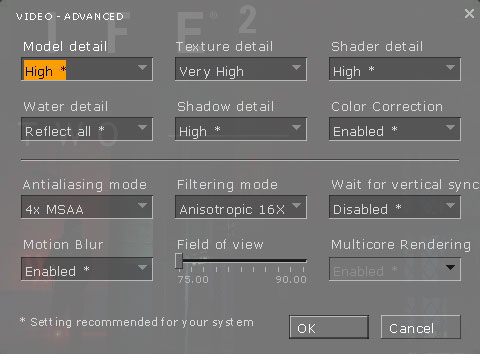
OS X HL2ep2 Settings
Multicore rendering is an option under Windows that isn’t adjustable under Steam for OS X, and despite the setting being greyed out as Enabled it doesn't appear to be enabled under OS X. In our benchmark with multicore rendering disabled both versions of the game eat up around 1.5 out of the 8 cores in the Mac Pro. Enabling multicore rendering in Windows bumps the average up to 2.4 cores, but drops performance at higher resolutions. I’ve provided both sets of results in the graph below so you can see what happens:
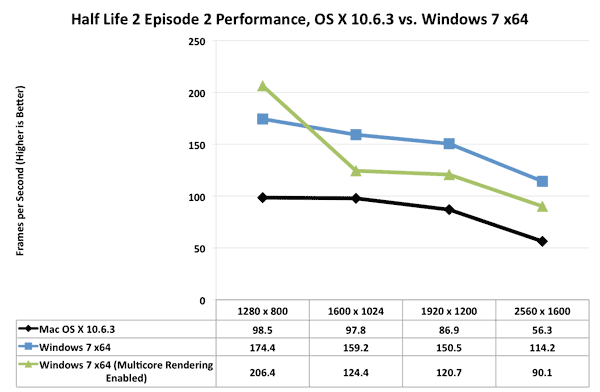
The Windows performance advantage with multicore rendering disabled ranges from 62% all the way up to 103%. Even at its worst, the GTX 285 under OS X is fast enough to make 2560 x 1600 playable, but it is noticeably slower than under Windows.
With multicore rendering enabled CPU bound performance goes up around 18%, but we see a drop at more GPU limited resolutions.
Image Quality: Still Foggy
As Ryan pointed out in his more timely piece, image quality under OS X is noticeably worse than under Windows.
The Mac screen shots are foggier for some reason and despite the fix that was applied to Portal, Half Life 2 Episode 2 appears to have worse texture filtering quality under OS X than Windows. This is more pronounced of a difference than what we saw under Portal.
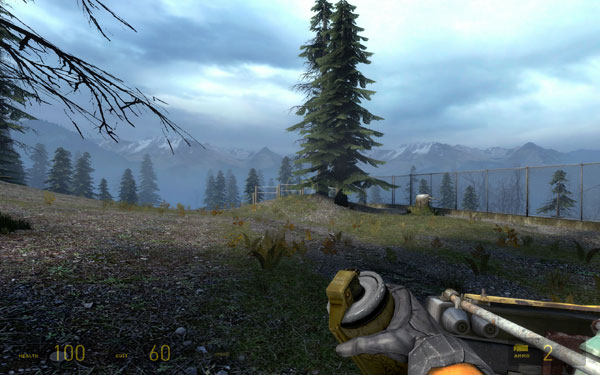
Half Life 2 Episode 2 - Windows 7 - Click to Enlarge
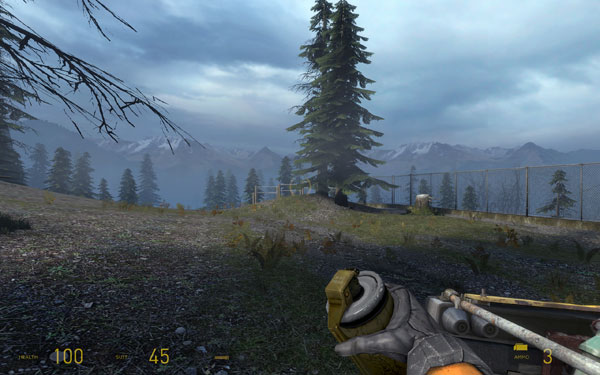
Half Life 2 Episode 2 - OS X - Click to Enlarge
It looks like something is wrong with the AF setting, reverting to Trilinear filtering confirms my suspicion:
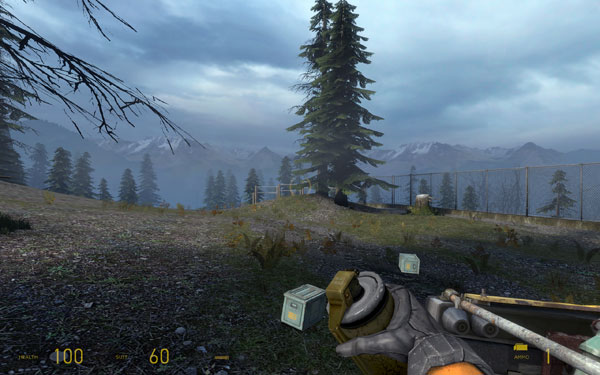
Half Life 2 Episode 2 - OS X - Trilinear Filtering - Click to Enlarge
But AF isn’t completely disabled. Using the Windows version for comparison it looks like Half Life 2 Episode 2 just forces 4X AF regardless of what you set the texture filtering option to:
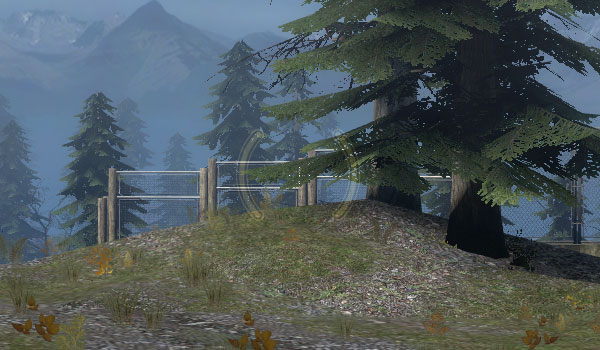
Windows 7 4X AF
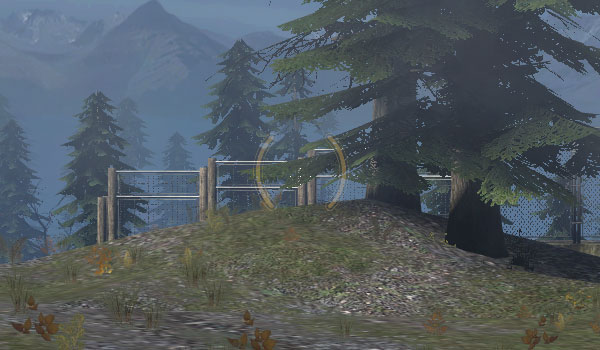
OS X 16X AF
The sky and muted colors are still a problem and I can’t seem to find out the cause of that one. There’s some texture banding off in the distance in the sky that’s only visible in the OS X version.
Final Words
The simple fact that Valve ported the Source engine to the Mac platform is enough to give the developers some leniency in improving performance. If Valve is truly committed to bringing all new releases on Steam to OS X than I doubt that Mac enthusiasts will be too bothered by the fact that performance is lower than under Windows, at least for a short while.
The Steam application itself is also slower under OS X. Launching games and the Steam application takes longer than under Windows.
| Half Life 2 Episode 2 Load Time | |||||
| Nehalem Mac Pro | Mac OS X 10.6.3 | Windows 7 x64 | |||
| Time from Launch to Menu | 48.7 seconds | 35.5 seconds | |||
Eventually performance and image quality parity will be necessary. Make no mistake, Apple is in the business of selling luxury computers. You can often get the same specs for less from Dell or HP, but the styling, attention to detail, ability to legitimately run OS X and user experience are all things Apple’s customers are willing to pay a premium for. A performance deficit rarely goes over well in these sorts of situations. It doesn't have to offer greater performance, but you shouldn't have to sacrifice so much just to play under OS X.
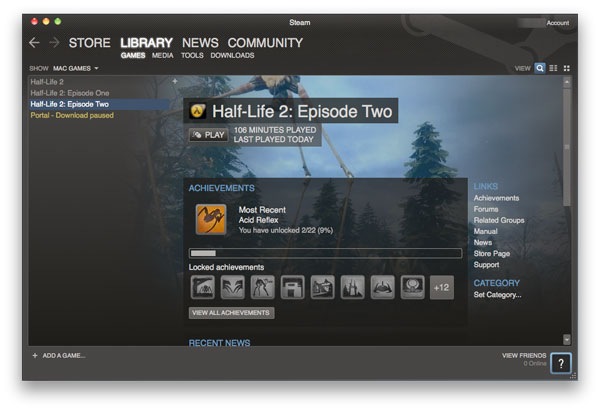
To Valve’s credit, at least on current generation Macs, Source engine games are absolutely playable. It supports Apple’s whole “it just works” mantra. You’re just better off running them in Windows if you have the option. Although I will admit that the convenience of not having to reboot is sometimes worth the frame rate penalty, at least for shorter gaming sessions. If I’m going to be playing for more than 20 minutes, then a reboot is more than worth it.







